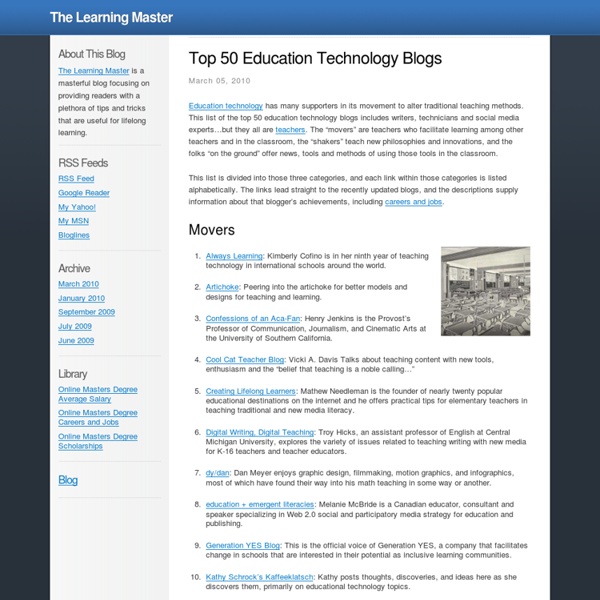NZ Interface Magazine | Eight habits of highly effective 21st ce
We hear a lot about the 21st century learner – but what about the 21st century teacher? Andrew Churches investigates what makes them succeed. What are the characteristics we would expect to see in a successful 21st century educator? 1. 2. 3. 4. 5. 6. 7. 8.
Kmitta, D., & Davis, J. (2004). Why PT3? An analysis
BibTeX @MISC{Kmitta_kmitta,d.,, author = {Daniel Kmitta and John Davis}, title = {Kmitta, D., & Davis, J. (2004). Why PT3? An analysis of the impact of educational technology. Contemporary Issues in Technology and Teacher Education, 4(3), 323-344. Bookmark OpenURL Abstract This paper examines three questions regarding the use of computer technologies and education. Citations
Top 10 Technology Blogs for Education
Editor's note: This is a cross post from College Online where "The Innovative Educator" is named in the top ten ed tech blogs list. I'm thrilled to be mentioned with all these other wonderful bloggers. I know and follow most of them and look forward to getting to know better those I don't. Education, as with all aspects of culture, is greatly impacted by the forward progress of technology. Check out our picks here: 1.
The Pursuit of Technology Integration Happiness
Classroom Collaboration Using Social Bookmarking Service Diigo (EDUCAUSE Quarterly
Key Takeaways Social bookmarking websites enhance and improve the learning experience by encouraging group collaboration and making organizing and saving web resources faster and easier for students. Social bookmarking services offer greater scope for research, integration, and collaboration compared to the more traditional bookmarking applications such as browsers, which offer limited functionality. Classroom collaboration is an area that benefits directly from today's Internet experience in that students can develop their potential for learning by becoming more actively involved. While many social bookmarking sites offer some collaboration opportunities, I have found that Diigo (Digest of Internet Information, Groups and Other stuff) combines a user-friendly social platform with bookmarking features, making it an effective research, integration, and collaboration tool for use in the classroom. Traditional Bookmarking Social Bookmarking Table 1. * Between Diigo and Delicious. Research
The Teacher Tap: Professional Development Resources for Educator
The Teacher Tap is a free, professional development resource that helps educators and librarians address common questions about the use of technology in teaching and learning by providing easy access to practical, online resources and activities. Check out the Project Overview for more information. For a more indepth look at these topics, go to our online courses including: We're in the process of updating this resource, so you'll find a mixture of old and new pages.
Transforming the Culture of High Scho
Society for Information Technology & Teacher Education International Conference, in Phoenix, AZ, USA ISBN 978-1-880094-55-6 Publisher: Association for the Advancement of Computing in Education (AACE), Chesapeake, VA Abstract Placing technology in schools and mandating an ICT program of studies is not enough to enable teachers and students to acquire the skills and proficiencies to use them effectively (Breuleux, 2001). Citation Saar, C. & Bechtold, S. (2005). OpenURL Keywords
Top 50 School Technology Blogs | Best Education Tech Blogs
Take a candid look into the day-to-day life of pioneers who play a vital role in outfitting students with 21st century skills by integrating new technologies in the nation’s schools. Blogs provide a platform for these trailblazing educators to share ideas and serve as a window into a profession that is truly transformative. iLearn Technology Check out the featured posts on iLearn Technology, where teacher-turned-tech integration specialist Kelly Tenkely offers nifty tech tips and tools like Math Pickle and Off-Road Algebra that make story problems relatable, along with entries in a series on professional development. Educational Technology and Mobile Learning Med Kharbach is the teacher, graduate student, and professional blogger behind Educational Technology and Mobile Learning. E-Learning Queen Susan Smith Nash has been involved with e-learning for more than two decades. The Nerdy Teacher Nicholas Provenzano is an edcamp speaker and runs the education e-zine ProjectPLN. Yes Tech!
Lisa Nielsen: The Innovative Educator
15 Free Tools for Web-based Collaboration
No man (or woman) is an island – and this statement can’t be any truer if you’re a designer or developer. Though paid/subscription services like Basecamp and Zimbra are great, individuals strapped for cash have a ton of alternatives that provide similar (if not better) features. In this article, you’ll find 15 free tools to help you facilitate remote/web-based collaboration. Whether you need basic whiteboarding/brainstorming tools or fully-featured project management applications – you should be able to find a tool or two that’s worth checking out. Google Docs Google Docs is an excellent application for collaboration. Stixy Stixy is a flexible, online “bulletin board”/drawing board. Project2Manage Project2Manage is a fully-featured, free, hosted solution for project management and collaboration (similar to Basecamp). bubbl.us bubbl.us is a free, web-based application for collaborative brainstorming. Dabbleboard Dabbleboard is a robust, online whiteboard that’s easy to use. Protonotes Twiddla



